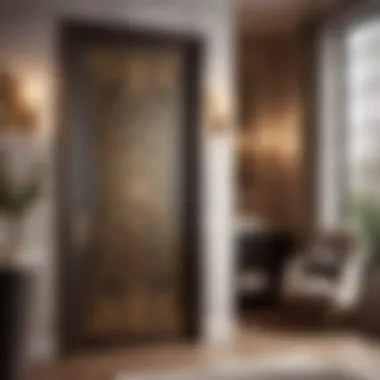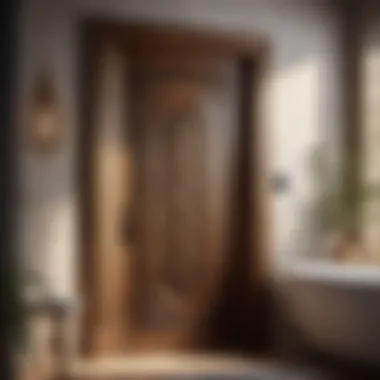Unveiling the Crucial Role of a Well-Crafted Bathroom Door


Materials:
- Solid wood door: 80 inches x 36 inches
- Door hardware kit: includes hinges, doorknob, latch
- Level
- Tape measure
- Screwdriver
- Drill
- Sandpaper
- Paint and primer
DIY Steps:
- Start by measuring the bathroom doorway to ensure the door fits properly. Cut the solid wood door to size using a saw if needed.
- Sand the edges of the door to smooth out any rough spots and create a uniform surface.
- Apply primer to the door surface and let it dry completely before painting. Choose a color that complements the bathroom decor.
- Install the hinges on the door frame using a screwdriver and drill, ensuring they are aligned correctly.
- Hang the door on the hinges and attach the doorknob and latch, following the manufacturer's instructions.
Technical Aspects:
- Timing: Plan for a weekend project to allow sufficient time for each step to dry and set properly.
- Tools: Ensure you have all necessary tools on hand before starting to avoid interruptions.
- Critical Techniques: Use a level to ensure the door is hung straight and functions correctly.
DIY Project Process:
- Measure twice, cut once to ensure the door fits perfectly in the doorway.
- Take your time sanding and painting to achieve a smooth and professional finish.
- Follow the hardware instructions carefully to prevent any issues with door operation.
- Test the door several times to ensure it swings smoothly and latches securely.
Troubleshooting Tips:
- If the door sticks, sand down the edges slightly for better clearance.
- For squeaky hinges, remove them, lubricate with WD-40, and reattach securely.
Providing a well-designed bathroom door enhances both the functionality and aesthetics of your space, adding a touch of sophistication and practicality to your home.
Introduction
A bathroom door might often be overlooked, but its design and functionality play a critical role in both residential and commercial settings. The significance of a well-designed bathroom door extends beyond mere aesthetics; it is a fundamental element that can significantly impact the overall ambiance and practicality of a space. As we delve into the various aspects of bathroom design, it becomes evident that the choice of door is a crucial decision that transcends basic functionality.
The first impression of a bathroom door sets the tone for the entire space, welcoming guests and residents alike. Beyond aesthetics, a well-crafted door can enhance the privacy and security of the area, promoting a sense of comfort and tranquility within the bathroom environment. From the dimensions and swing options to the material selection and styles, each decision in the design process contributes to the door's overall impact on the room. Hence, understanding the importance of a meticulously planned bathroom door is key to creating a harmonious and functional space.
In this article, we will explore the multifaceted role of a well-designed bathroom door, dissecting its functional, aesthetic, and practical implications. By examining the essential elements and considerations in door design, we aim to provide readers with a comprehensive guide to making informed decisions that align with their specific needs and preferences.
Functional Aspects


Size and Dimensions
The size and dimensions of a bathroom door are fundamental aspects that directly impact its functionality. It is essential to consider the space available for the door swing, ensuring it does not obstruct other bathroom fixtures or impede movement within the room. Standard door sizes may not always be suitable for every space, and custom sizing might be necessary to achieve the desired functionality. Additionally, the height of the door should be adequate for privacy while ensuring ease of access for different users, including children and individuals with mobility challenges.
Swing Options
Choosing the right swing option for a bathroom door is crucial for optimizing space utilization and convenience. The selection between inward and outward swings should be based on the layout of the bathroom and the adjacent areas. In smaller bathrooms, an inward swing might be preferred to conserve space, while larger bathrooms may benefit from an outward swing for easier access and better ventilation. Additionally, considering alternative swing configurations such as pocket doors or sliding doors can offer unique solutions for maximizing space efficiency and aesthetics.
Material Selection
The material chosen for a bathroom door significantly impacts its durability, maintenance requirements, and overall aesthetic appeal. Wood, fiberglass, steel, and glass are common materials used for bathroom doors, each offering unique benefits in terms of resilience, moisture resistance, and design versatility. When selecting a material, it is essential to consider factors such as humidity levels, maintenance preferences, and desired aesthetic coherence with the rest of the bathroom decor. Investing in high-quality materials not only enhances the longevity of the door but also elevates the entire bathroom's visual appeal.
Aesthetic Considerations
In this article, we aim to highlight the pivotal role that aesthetic considerations play in selecting the ideal bathroom door. By focusing on key design elements, benefits, and essential considerations, we provide readers with valuable insights into how to make informed decisions that align with their personal style and design preferences.
Style Choices
The style of a bathroom door is a critical aspect that greatly influences the overall ambiance of the space. Whether opting for a sleek modern look, a charming traditional design, or a minimalist aesthetic, the style of the door sets the tone for the entire bathroom. It reflects the homeowner's taste and contributes to the cohesion of the interior decor.
In this section, we delve into various style choices available for bathroom doors, ranging from contemporary to classic options. We explore how different styles impact the visual appeal of the space and discuss how to harmonize the door style with the existing décor for a seamless and polished look.
Color and Finish
The color and finish of a bathroom door are pivotal components that can enhance or detract from the overall design scheme. Choosing the right color palette and finish is essential in creating a cohesive and aesthetically pleasing environment. Whether opting for a bold pop of color to make a statement or a subtle hue to complement the existing decor, the color and finish of a door contribute significantly to the space's visual impact.
In this segment, we delve into the significance of color and finish selection for bathroom doors. We discuss how different color choices can evoke various emotions and moods within the space, as well as how different finishes can add texture and depth to the overall design. Our aim is to guide readers in making informed decisions that align with their design vision and enhance the esthetic appeal of their bathrooms.
Impact on Overall Design
The bathroom door's aesthetic choices have a profound impact on the overall design of the space. Whether aiming for a cohesive and integrated look or a contrasting element to create visual interest, the bathroom door is a key component in shaping the room's design language. It not only serves a functional purpose but also contributes significantly to the space's overall aesthetic coherence.
In this section, we analyze how the aesthetic considerations of a bathroom door influence the broader design of the bathroom. We explore how incorporating the right door design can tie together different elements within the space, creating a harmonious and visually appealing environment. By understanding the door's impact on the overall design, readers can make well-informed decisions that elevate the style and functionality of their bathrooms.


Privacy and Security
When it comes to the design of a bathroom door, one of the paramount considerations is privacy and security. These elements play a crucial role in creating a functional and safe environment within your residential or commercial space. Privacy in a bathroom setting is not just about seclusion but also about feeling secure and at ease while using the facilities. A well-designed bathroom door with adequate locking mechanisms, soundproofing, and visual privacy features ensures a comfortable and private experience for users.
Locking Mechanisms
Locking mechanisms on a bathroom door are fundamental in ensuring privacy and security. Choosing the right lock for your bathroom door is essential to prevent any mishaps or interruptions while the space is in use. From traditional locks to more modern electronic options, the locking mechanism should be easy to operate yet secure enough to provide peace of mind. Consider factors such as convenience, durability, and reliability when selecting the locking mechanism for your bathroom door.
Soundproofing
Soundproofing is another critical aspect to consider when designing a bathroom door. An effective soundproof door can help reduce noise transmission between rooms, maintaining a quiet and peaceful environment. Whether in a bustling household or a busy commercial setting, investing in soundproofing for your bathroom door can enhance privacy and comfort for all occupants. Consider using materials that offer sound-dampening properties and ensure a snug fit to minimize sound leakage.
Visual Privacy
Visual privacy is equally important for a well-designed bathroom door. Optimal visual privacy ensures that users feel comfortable and secure while using the bathroom facilities. Factors such as frosted glass, opaque materials, or strategic placement of windows can enhance visual privacy without compromising on aesthetics. Balancing visual appeal with privacy considerations is key to creating a welcoming and secure bathroom environment for residents or patrons.
Hardware and Accessories
When considering the design and functionality of a bathroom door, hardware and accessories play a pivotal role in enhancing both the aesthetic appeal and practicality of the space. The choice of hardware and accessories can significantly impact the overall look and feel of the door, as well as its ease of use and longevity. It is essential to pay attention to the details of handles, knobs, hinges, closers, and additional features, as they can make a substantial difference in the user experience and the overall design cohesion.
Handles and Knobs
Handles and knobs are not just functional elements but also design accents that can uplift the aesthetics of a bathroom door. The ergonomic design of handles ensures easy gripping and effortless operation, especially for individuals with mobility issues or children. Knobs, on the other hand, offer a classic and elegant touch to the door. When selecting handles and knobs, one must consider the material, finish, and style to complement the overall decor theme. Materials like stainless steel, brass, or matte black are popular choices for modern bathrooms, while antique brass or brushed nickel can add a vintage charm.
Hinges and Closers
Hinges and closers are the unsung heroes of a bathroom door, providing smooth opening and closing mechanisms while ensuring durability and stability. High-quality hinges prevent sagging or misalignment over time, maintaining the door's functionality. Closers, such as hydraulic or spring mechanisms, control the door's speed and prevent slamming, enhancing safety and convenience. Choosing hinges and closers that match the door's style and weight is crucial for seamless operation and longevity.
Additional Features
Apart from standard hardware components, bathroom doors can incorporate additional features for enhanced functionality and convenience. Features like soft-close mechanisms reduce noise and prevent accidental finger injuries, making them ideal for households with children. Moreover, integrated privacy locks or smart lock systems can offer added security and peace of mind. Consider incorporating peepholes, soundproofing seals, or even automatic door openers for a touch of luxury and modernity. These additional features not only elevate the user experience but also increase the door's value and efficiency in a residential or commercial setting.


Maintenance and Durability
The section on maintenance and durability plays a pivotal role in understanding the longevity and optimal functionality of your bathroom door. When it comes to maintaining and ensuring the durability of your door, there are crucial factors to consider to uphold its purpose and aesthetics over time.
For starters, regular cleaning is essential to prevent the build-up of dirt, grime, and bacteria on the door's surface. Using a mild detergent and non-abrasive cloth can help maintain the door's finish without causing any damage. Additionally, keeping the door dry after each use can prevent water damage and warping of the material, enhancing its longevity.
To further bolster the durability of your bathroom door, inspecting hinges, handles, and knobs for any signs of wear and tear is vital. Tightening loose screws and lubricating moving parts can prevent premature deterioration and ensure smooth operation. Moreover, periodically checking for any cracks or deformities in the door itself can help address minor issues before they escalate, preserving the door's structural integrity.
Considering the investment that goes into selecting a well-designed bathroom door, understanding how to maintain and enhance its durability is paramount. By incorporating regular cleaning routines, addressing wear and tear promptly, and ensuring proper care, you can extend the lifespan of your door while upholding its aesthetic appeal and functionality for years to come.
Cleaning Tips
When it comes to cleaning your bathroom door, using gentle cleaning solutions is key to preserving its finish and material integrity. Avoid harsh chemicals that can corrode or strip the door's surface, opting instead for mild cleansers that can effectively remove dirt and stains without causing damage. Using a soft cloth or sponge dampened with the cleaning solution, gently wipe down the door's surface in a circular motion, paying extra attention to corners and edges where dirt accumulates.
For stubborn stains or buildup, a mixture of warm water and vinegar can serve as a natural and effective cleaning solution. This can help dissolve mineral deposits or soap scum without compromising the door's finish. Once cleaned, ensure the door is thoroughly dried to prevent water damage or mildew growth. By incorporating regular cleaning practices using gentle solutions, you can maintain the brilliance and cleanliness of your bathroom door effortlessly.
Longevity Factors
The longevity of a bathroom door is influenced by various factors, ranging from material selection to proper maintenance practices. Choosing high-quality materials such as solid wood, fiberglass, or PVC can significantly impact the door's lifespan and durability. These materials are known for their resistance to moisture, warping, and scratching, ensuring that your door maintains its structural integrity over time.
In addition to material selection, the installation process and climate conditions can also affect the longevity of your door. Ensuring that the door is correctly installed with appropriate seals and weather-stripping can prevent water damage and drafts, prolonging its lifespan. Moreover, controlling humidity levels in the bathroom and providing adequate ventilation can prevent moisture-related issues that may compromise the door's durability. By considering these longevity factors and taking proactive measures to protect your door, you can extend its lifespan and uphold its functionality for years to come.
Repair and Replacement
Despite proper maintenance efforts, there may come a time when repair or replacement of your bathroom door is necessary. Whether due to extensive wear and tear, structural damage, or aesthetic preferences, knowing when and how to repair or replace your door is essential in maintaining the overall functionality and appeal of your space.
When encountering issues such as squeaky hinges, loose doorknobs, or damaged surfaces, addressing these concerns promptly can prevent further damage and ensure smooth operation. Simple repairs like tightening screws, lubricating moving parts, or refinishing the door can often resolve minor issues and extend its lifespan. However, in cases where the damage is extensive or beyond repair, opting for a replacement door may be the most practical solution.
When considering a replacement door, factor in the existing design and size requirements, as well as the desired material and finish to seamlessly integrate the new door into your space. By understanding when to repair or replace your bathroom door and taking prompt action, you can maintain the functionality and aesthetic appeal of your space effectively.
Conclusion
One of the key elements to consider when evaluating the significance of a bathroom door is its ability to marry both functionality and aesthetic appeal seamlessly. A well-chosen door can elevate the design of the entire space, serving as a focal point that enhances the overall atmosphere of the bathroom. Additionally, the practical aspects such as choosing the right material, size, and swing options are vital in ensuring that the door not only looks good but also serves its intended purpose effectively.
Furthermore, the privacy and security features offered by a well-designed bathroom door are paramount, especially in a residential setting where occupants require a sense of seclusion and safety. Factors such as locking mechanisms, soundproofing capabilities, and visual privacy all contribute to creating a secure and comfortable environment within the bathroom.
Considering the hardware and accessories that complement the door is also essential. Handles, knobs, hinges, and closers should not only align with the overall design scheme but also provide practicality and ease of use. Additional features such as automatic closures, soft-close mechanisms, or integrated lighting can further enhance the user experience and convenience.
In terms of maintenance and durability, a high-quality bathroom door can stand the test of time with proper care and attention. Regular cleaning routines, understanding longevity factors of different materials, and being prepared for repairs or replacements when necessary are all part of ensuring the door retains its functionality and appeal over the long term.







